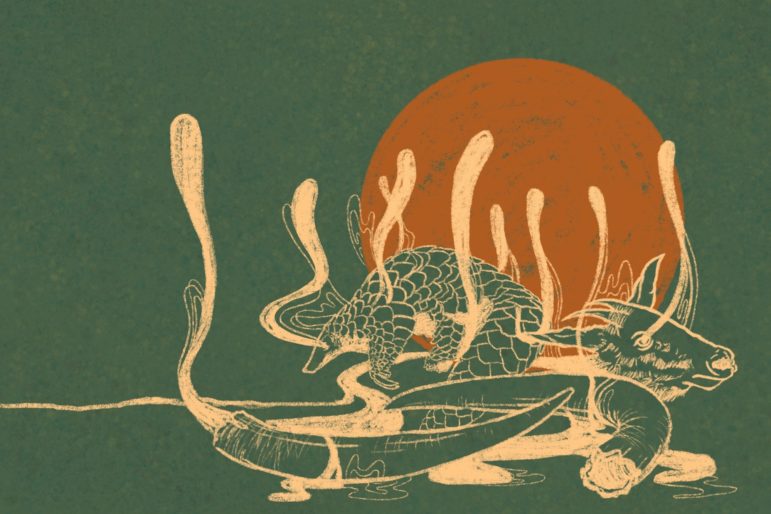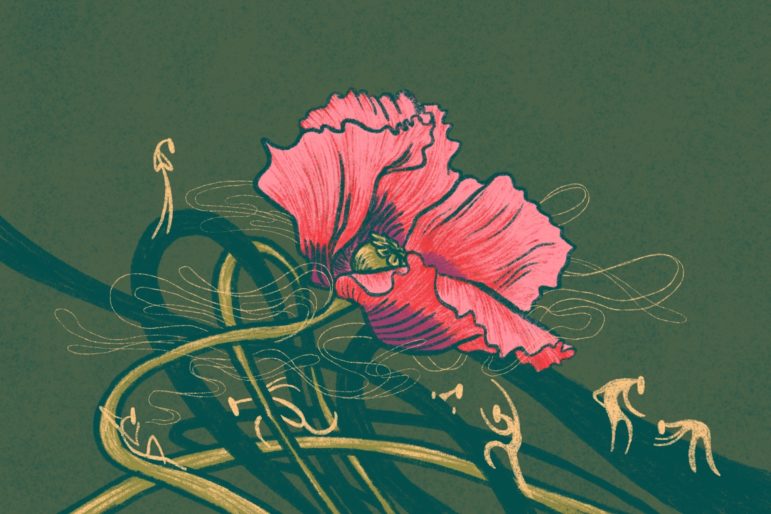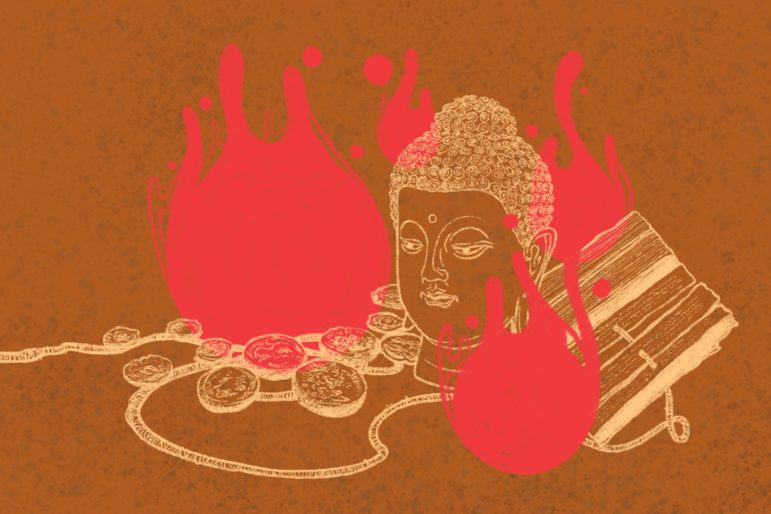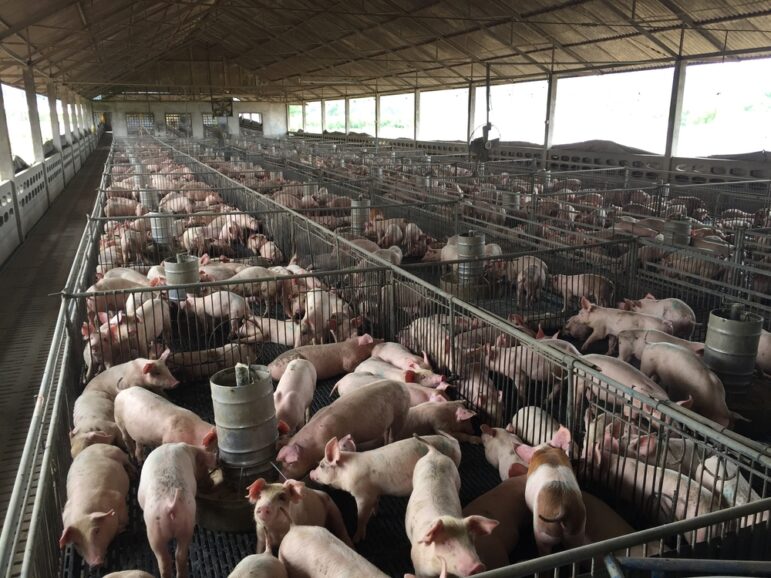

Illustration: Nodjadong Boonprasert for GIJN
Guide to Investigating Organized Crime in the Golden Triangle: Chapter 5 — Wildlife Trafficking
Chapter Guide Resource
Guide to Investigating Organized Crime in the Golden Triangle — Introduction
Chapter Guide Resource
Guide to Investigating Organized Crime in the Golden Triangle: Chapter 1 — Drug Trafficking
Chapter Guide Resource
Guide to Investigating Organized Crime in the Golden Triangle: Chapter 3 — Money Laundering
Chapter Guide Resource
Guide to Investigating Organized Crime in the Golden Triangle: Chapter 4 — Human Trafficking
Chapter Guide Resource Video
Video: Investigating Organized Crime in the Golden Triangle
Table of Contents | Introduction | Chapter 1 | Chapter 2 | Chapter 3 | Chapter 4 | Chapter 6
The once-sleepy town of Mong La, on Myanmar’s border with China, first became a center for drug-trafficking and gambling but now has also developed into a hub for the illegal trade in wildlife products.
This was highlighted as early as 2017 in a report compiled by Traffic, an NGO mapping the illegal trade in wild animals and plants. Based on its investigations, including visits to Mong La, Traffic identified 10 of the most widely trafficked animal products in the Golden Triangle: tiger skins, paws, and bones; parts of elephants such as ivory, teeth, hair, bones, tails and trunks; meat and scales from pangolins; bears and especially their bile; rhinoceros horns; serows (a goat- or antilope-like species); hornbills (a bird species); the bison-like gaurs; leopard skins; and various kinds of turtles. The main market is China, where rhinoceros horns are believed to be an aphrodisiac, while bear bile and pangolin meat are considered a delicacy. Pangolin scales are also popular in traditional medicine in China and Vietnam. Wildlife products for sale in Mong La come from Myanmar itself but also from northeastern India (rhino horns and tiger products) and as far away as Africa (rhino horns).
Wildlife products are also for sale in the Golden Triangle Special Economic Zone (GTSEZ) in Laos’s Bokeo Province. According to the NGO Environmental Investigation Agency (EIA), there are even a number of criminal-run tiger “farms” inside the GTSEZ where tigers are bred and then sold. EIA wrote in a 2015 report: “The complex comprises a casino, hotels, shops, restaurants, a shooting range, and massage parlors — and visitors can openly buy endangered species products including tigers, leopards, elephants, rhinos, pangolins, helmeted hornbills, snakes and bears, all smuggled in from Asia and Africa.”

In a 2015 report, the Environmental Investigation Agency tracked the trade in tigers and tiger products through the Golden Triangle Special Economic Zone (GTSEZ). Image: EIA
This trade is run by international criminal gangs that are also involved in narcotics, money laundering, and human trafficking. The exact value of the Golden Triangle trade in wildlife products is not known but the total global trade is reported to be in the order of US$23 billion. According to the European Commission, illegal trafficking in wildlife products is believed to be the fourth-most lucrative transnational crime after drugs, weapons, and human trafficking. Due to the lawless nature of the Golden Triangle, it is hardly surprising that a large part of the regional as well as global wildlife trade takes place there.
How It Works
A detailed report on how the illegal wildlife trade in the Golden Triangle works was published in the scholarly journal Trends in Organized Crime 2021. The growth of the trade in wildlife came in the wake of the major events in the Golden Triangle and adjacent territories, including the 1989 collapse of the Communist Party of Burma (CPB) and China’s economic boom in the 1990s, which resulted in the emergence of a new class of Chinese entrepreneurs in search of business opportunities. The former CPB forces’ deal with the Myanmar government, which enabled them to set up autonomous areas along the Chinese frontier and expand their involvement in the drug trade, made it possible for them to engage in other types of illegal activities — and one of the most lucrative turned out to be the trade in wildlife products.
Mong La, under the control of the National Democratic Alliance Army-Eastern Shan State (NDAA-ESS), became the main center for that trade. The group’s leaders had excellent contacts with local officials across the border in China’s Yunnan province as well as with ethnic Chinese criminal organizations. At the same time, a series of policy initiatives in Laos encouraged a more open market-oriented economy. Private traders were allowed to compete with state enterprises and the cross-border trade with China increased dramatically as a result of these new policies. As the authors of the article in Trends in Organized Crime point out: “This… strengthened China’s long standing connections with northern Laos and eastern Myanmar. However, it also facilitated cross-border trafficking of contraband and provided opportunities for crime groups to diversify into new illegal markets in the borderlands of the Golden Triangle.”
This shift in Lao economic policy led to the establishment of the GTSEZ in 2007. Its reputation for lawlessness soon became well-known and, in 2022, Investment Monitor branded it “the world’s worst special economic zone.” A major reason for this stems from the Lao government’s decision to lease the GTSEZ land to the Kings Romans Group, a Hong Kong-registered company. As a result, the zone no longer falls within the jurisdiction of the government in Vientiane. This arrangement is essentially permanent, since the lease was signed in 2007 and lasts for 99 years.
Radio Free Asia (RFA) reported on June 25, 2021 that there are even plans to build an international airport inside the zone. RFA also reported that the chairman of a Kings Romans affiliate that actually runs the casino “has been tied to human trafficking, money laundering, and the illegal trade in drugs and wildlife products.” In 2018, the US Treasury Department declared this business network, including the Golden Triangle’s well-known Kings Romans Casino, a “transnational criminal organization” and sanctioned the chairman as well as related individuals and companies across Laos, Thailand, and Hong Kong.
Origins and Markets for Wildlife Trafficking
When reporting on ethnically-based crime, it is important to remember that entire communities should not be besmirched and made out to be criminals. “Ethnically-based crime” simply means that criminals from a certain ethnic group find it easier to deal with, and trust, people from the same community — and that is the case when it comes to wildlife products. Ethnic Chinese crime gangs, drawing on the worldwide Chinese diaspora, operate all over Southeast Asia, North and South America, and South Africa as well.

The poaching of tigers for the global trade of their skins may be outsourced to local organized crime elements. Image: Shutterstock
Chinese crime gangs use South Africa as a regional base and rely upon local connections to move wildlife products from across southern Africa to places such as Mong La, one of few locations in the world where the trade can be conducted openly. But the trade is more complex than that. According to Trends in Organized Crime: “The organized crime group may then outsource certain illegal activities to local crime groups… for example, a crime group involved in the trade of tiger skins may outsource the task of poaching, product promotion and product delivery to local crime groups.” From Mong La and the GTSEZ, wildlife products are smuggled into China, the main market, but also Vietnam where there is a demand for what is termed “traditional medicine.”
Recent developments, especially in the post-COVID-19 era, are outlined in a 2021 report published by the Center for Strategic and International Studies. It looked into the digitalization of illegal wildlife trafficking, a new trend that has made combating crimes exponentially more difficult and, therefore, harder to report on.
Tips and Tools
The GTSEZ is easily accessible from the Thai side via speedboats that cross the Mekong River from Chiang Saen to the casino complex in Laos. (Citizens of most countries can get 30-day visas on arrival on the Lao side and the fee is around US$35). It is far more difficult to get to Mong La in Myanmar, however. Previously, foreigners could travel overland from Kengtung in eastern Myanmar, but that route has been closed for quite some time. It could be easier for Asian travelers because, unlike Westerners, they are seldom checked. Kengtung is in a government-controlled area and there is a “border” between it and the territory controlled by the NDAA-ESS and soldiers from both that group and the Myanmar Army check all arrivals on their respective sides of the “border.”
Extreme caution should be observed when entering the GTSEZ as well as Mong La (if that is possible), especially when taking photographs. Remember that those places are run by ruthless criminals who would not hesitate to harm foreign journalists snooping into their affairs. But it is possible to get a feel for those places, and what goes on there, simply by walking around and exploring the casinos, markets, and entertainment venues.
Apart from the links mentioned above, there is a trove of information available online. Traffic, the NGO, has compiled a very comprehensive identification guide to assist enforcement officers combat wildlife crime in the Golden Triangle and a detailed report on the big cat trade in Myanmar and Thailand. China’s role as the world’s foremost market for wildlife is outlined in a 2021 paper published by Frontiers. Mongabay, a conservation news web portal devoted to environmental issues, has also compiled some reports about the Golden Triangle wildlife trade, which can be found here, here, and here. The first gives a general overview while the second lists the most widely traded animals. The third, the most recent of those reports, contains undercover video footage of a tiger farm “run by an organized criminal organization” in Laos.
There are also NGOs in Thailand that investigate the illegal trade in wildlife products, and the best informed is Traffic. The EIA is another useful source, and so is the World Wildlife Fund.
Case Studies
In the past — and before the Myanmar government made it difficult for foreigners to travel in sensitive frontier areas — several journalists visited Mong La. One of the most comprehensive articles written during that time appeared in the June 2016 issue of Cross-Currents: East Asian History and Culture Review. The authors — Alessandro Rippa and Martin Saxer — give a vivid description of the city, the illegal activities there, and a historical background to the emergence of this unique, lawless area along Myanmar’s border with China. They wrote: “Mong La’s success is… based on a network of gamblers, smugglers, ex-communists, rebel army leaders, and drug lords.” They could, however, have added corrupt officials on the Chinese side of the border as well as in Myanmar government-held areas south of the NDAA-ESS’s self-governed zone.

Journalists traveling to Mong La, Myanmar, should exercise extreme caution, especially when taking photographs. Image: Shutterstock
Mizzima, a website run by Myanmar exiles, published a very good 2020 report on Mong La. Written by Sai Wansai, who belongs to the Shan ethnic group, it quoted extensively from studies written by Myanmar academics before the 2021 coup. Apart from outlining developments in Mong La, Sai Wansai also looked into the illegal wildlife trade in Kachin State in northernmost Myanmar. Due to the difficulties getting into the NDAA-ESS area would entail, no more recent articles from Mong La have been done as of late 2022.
Arrests of smugglers elsewhere have been covered in the international media. One recent example is an October 2022 report from Al Jazeera on the extradition of an alleged Malaysian wildlife trafficker to the US to face charges of participating in a conspiracy to smuggle 70 kilograms of rhino horns, valued at more than US$725,000. According to the US Treasury Department, the suspect “specializes in the transportation of rhino horn, ivory, and pangolins from Africa, generally utilizing routes through Malaysia and Laos and onward to consumers in Vietnam and China.” That would most certainly involve gangs in the GTSEZ, because they are the only ones with networks that span Laos, Vietnam, and China.
In August 2018, the Lao government announced that it would close down the illegal trade in wildlife in the Golden Triangle. But, as a 2020 investigative piece on the website Lifegate reported, that did not stop illegal wildlife trafficking. Instead, the practice transitioned to “under the counter, with illegal traders and wildlife criminals resorting to social media platforms for their sales. The Chinese messaging, social media, and payment app WeChat is increasingly being used as a means for the illegal wildlife trade.”
India is another country where there is a demand for exotic and endangered species, as shown in a 2022 article in The Diplomat. Among these targeted animals are chimpanzees, pangolins, snakes, lizards, and wild cats. They are smuggled from Myanmar into the northeastern Indian states of Mizoram and Manipur. The inclusion of chimpanzees, which are not found in the wild in Myanmar, shows that the network has global connections. According to Rajeev Bhattacharyya, an investigative journalist based in Guwahati in northeastern India: “India is both a source and a transit country for illegal wildlife and wildlife items [and] ranks among the top 20 countries for wildlife trafficking.”
Table of Contents | Introduction | Chapter 1 | Chapter 2 | Chapter 3 | Chapter 4 | Chapter 6
Additional Resources
Reporter’s Guide to Investigating Organized Crime
Illegal Wildlife Trafficking: A GIJN Guide
Beyond Elephants and Rhinos: Tips For Covering Wildlife Trafficking
 Bertil Lintner is the author of 22 books on Asian history, politics and crime. He is currently with Asia Times and a former correspondent with the Far Eastern Economic Review, the Swedish daily Svenska Dagbladet, and Jane’s Information Group in the UK. Lintner lives with his family in Chiang Mai, northern Thailand.
Bertil Lintner is the author of 22 books on Asian history, politics and crime. He is currently with Asia Times and a former correspondent with the Far Eastern Economic Review, the Swedish daily Svenska Dagbladet, and Jane’s Information Group in the UK. Lintner lives with his family in Chiang Mai, northern Thailand.















